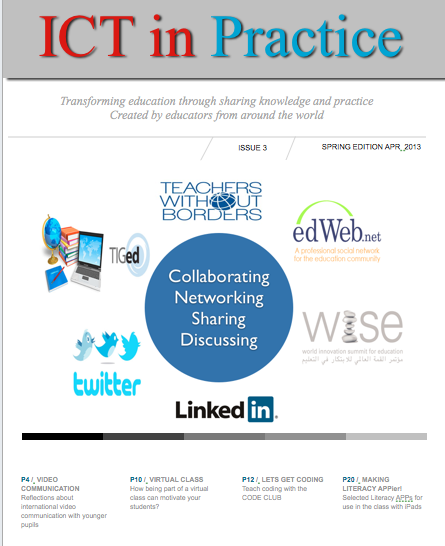Teaching kids Big Data and applying these concepts to the study of History through the PBL approach by Chris Carter and Peter Tong, Ph.D.
“Information is not knowledge, knowledge is not wisdom, and wisdom is not foresight. Each grows out of the other, and we need them all.” – Arthur C. Clark, Scientist and Author
We would add that data is not even information. Data is potential, nothing more. Data in its raw form is like an unpolished diamond: it is of no value until it is analyzed, tabulated and presented in a form that is understood. Mathematicians, statisticians, scientists and computing scientists transform raw data into comprehensible and usable information. Big Data Analytics (BDA) is the current term used to describe the process of harvesting fantastic amounts of raw data and transforming these data into valuable information that can be understood and used productively to gain insights into trends that are otherwise invisible. People in diverse fields ranging from business, economics, social sciences, arts and humanities, and the hard sciences are realizing the need for understanding what Big Data is and how it can be applied to benefit the commercial, industrial, and academic fields.
At Concordia International School Shanghai we offer a Big Data Analytics (BDA) course, thus providing an opportunity for a paradigm shift in teaching. However, there are no established teaching resources of any kind for Big Data at the high school level and, as with any new subject, it has to start somewhere. The course instructor took the opportunity to teach this course using a “guide on the side” approach, a teaching method discussed by Alison King in College Teaching, “From Sage on the Stage to Guide on the Side.”(1) This is a very powerful method of teaching where students are being “guided on the side” by the teacher, as opposed to listening to the “sage on the stage” teaching method where the teacher directly delivers information to the students. In today’s learning environment where new subject matters and information are rapidly evolving, it is very difficult to assemble current material from which students can refer. Hence, it is important for students to learn how to teach themselves, how to develop learning material and techniques, how to look for information and how to effective communicate that information to others. In accordance with the proverb, “Give a man a fish and you feed him for a day; teach a man to fish and you feed him for a lifetime,” these learning skills not only allow students to learn subject matter in the classroom, but also give students the tools to teach themselves in future new subject areas. The goal of an educator lies beyond the mere retention and application of knowledge, and extends to the ability to create a confident learning environment, where students gain confidence in their learning abilities and become confident in their roles as lifelong learners.
Through this method, students are empowered by their independent learning abilities and, as a result, they feel a greater sense of achievement in both their education and in themselves.
Teaching BDA is most efficient when the teaching method reflects the open-ended and perpetual nature of information as it currently materializes. At the high school level, the methodology of a BDA course delivery refers to King’s “guide on the side” teaching method. The teacher is required to have a structured framework of clear guidelines, objectives and goals for the course. This teaching method also allows the teacher to bring out the strengths and insights of their students while allowing students to make improvements to their areas of weakness, through the students’ investigation of the subject matter.
This new course is designed as a peer-learning course with the teacher in a facilitator role. For this pilot course, students deliver the daily lessons under the teacher’s guidance. The source materials for each lesson primarily come from Viktor Mayer-Schönberger’s and Kenneth Cukier’s Big Data: A Revolution That Will Transform How We Live, Work, and Think(2), further clarified through images, video clips, and short readings that bring the lessons to life.
While the general concepts of Big Data are taught through student lecture style and peer discussions, the practical learning of this course occurred through its applications. The teacher incorporates both group and individual projects in coordination with the BDA course educational goals, with reference to Bloom’s taxonomy as checkpoints: Knowledge, Comprehension, Application, Analysis, Synthesis, and Evaluation. The students are given in-class time for peer discussions and to further research the materials taught after each lecture. At the end of each subsection the students orally present their knowledge and comprehension of the material by creating summaries of topics through multiple means of delivering understanding of the contents.
Since this course is designed to be student-centered and to highlight the students’ strengths and interests, students are required to research their topic of interest on Big Data applications. However, the final presentation is more than a summation of their research interests; it requires a large-scale (1.8m x 2.0m) info-graphic and presentation to the school’s administration team, the head of school and the parent community, many of whom are industry professionals. The opportunity to present these findings to an audience of high-level business people takes advantage of the human resources available in the community and adds a level of achievement for the students: professional interaction and showcasing.
The course connects students to their school, and local and global communities, in addition to the academic community. Big Data university academicians are brought in as guest lecturers via Skype. The guest lecturers are an important element of this course as they provide external feedback from experts and give students a prime opportunity to learn the relevance and potential of Big Data in post-secondary education and beyond.
The course opens doors to real-world exposure and networking opportunities for the students. One of the students now has a head start in her academic career as she networked with one of the guest professors, and is now collaborating with the professor on an undergraduate research project that she will complete upon entering university. While this student is only one among many examples, the overall outcome of the course surpasses initial expectations, including in the realm of cross-curricular cooperation.
One such cross-curricular endeavor currently in process is applying Big Data tools to the study of History. The collaboration began as a serendipitous conversation between the Big Data and Advanced Placement European History teachers. The conversation quickly led to applying Problem-Based Learning (PBL) to BDA, focusing on a question of history. Problem-Based Learning is “a teaching method in which students gain knowledge and skills by working for an extended period of time to investigate and respond to an engaging and complex question, problem, or challenge.”(3)Two clear and concise videos explaining PBL are Project Based Learning: Explained(4) and Introduction to Project Based Learning (PBL) Process(5). The most organized and useful site for instructors who are considering PBL is Buck Institute for Education(6).
A previous example of historians using Big Data techniques at the post-graduate level can be found in comparisons of American colonial life in the Chesapeake and Massachusetts Bay regions. Prior to recent work historians had little statistical means to put numbers to the arguments, being built largely on primary source documents of the individuals who lived in the regions. Applying Big Data techniques historians slowly, tediously, built data sets from “records of baptisms, marriages, and deaths; property-holding and tax records; civil or criminal court records; military records; ship manifests; slave auction records(7); and cemetery records …” that heretofore had survived separately in numerous archives. By using techniques commonly found in Big Data (aggregation of data, data overlay, anomaly detection, clustering, behavioral analytics, etc.) Historians found hard evidence of shifts in cultural patterns that had previously only been inferred. A stronger case for the economic models being the driving force behind colonial choices emerged.
Working with the AP European History teacher, BDA students took on a similar task of building data sets and applying Big Data techniques to history. The students examined economic data from European countries from the years 1900 to 1939, focusing on the five major players involved in World War II. Their focus question was, to what degree can unique economic stresses account for Germany’s election of Hitler to guide the German state in 1933? Touch-points were created as the project moved forward. Cobbled from notes, these steps were:
• Collect data
• Organize data into logical sets
• Examine data for patterns, anomalies, and changes over time – Visualization of data begins here
• Arrange data sets into logical order – Primary and Secondary sets begin here
• Overlay data sets to look for correlations and addition patterns
• Cut data to tell a story
• Visualize data into a “dashboard” that is clear
• Present data visualizations and insights to authentic audience
Time being limited the data-gathering portion was necessarily truncated. B.R. Mitchell’s International Historical Statistics: Europe 1750-2005 (8)served as the source for all economic data. After data sets were painstakingly created, the analysis began. Immediately the teacher became the guide and coach, not the expert.
The students generated the questions, found the answers, and taught each other. For a teacher used to being in the front of the classroom it was a significant learning experience. The students’ insights gained from analyzing the data demonstrate the degree of critical thinking and learning taking place. Sample questions generated, researched, answered and taught among the students include:
• What do I do with missing data? Not every year for every country is recorded.
• Can forms of alcohol consumption be rough substitutes for a “hopefulness” or “hopelessness” index?
• Is petroleum production or gasoline production a better indicator of economic strength?
• Which resources are linked with each other, and which ones have priority over the others?
With the end of the semester the data sets were compiled, annotated, and placed in a Google Drive folder for pass-through to the next class. The entire exercise occupied approximately seven hours of classroom time. Next semester the Advanced Placement European History students will pick up the challenge. With the data sets assembled, these new students will analyze the results to answer the question that began the process.
Samples of student analysis follow:
“Electricity Output-Germany has the most output and a more drastic increase. … USSR held the last place output quantity until 1932 when their output quantity surpassed that of Italy and continues to drastically increase, hitting a peak in 1941. This indicates a quick development in technology and economy in … USSR as their electricity output increases. At the same time, technology in Germany was the best at the time, and rapidly improving. The contrast of outputs shows us the different development patterns of two countries …”
“Output of Artificial and Synthetic Fibers: The numbers for all five countries started about the same … The number constantly increased. Starting from 1935, the differences between the countries are starting to show. Even though all the numbers are getting larger, the output of Fibers started to increase significantly in Germany. Germany reached its highest point in 1942, … probably used to make new clothes for soldiers, build military tents, etc. because it was cheap and stronger. After losing WW1, Germany was probably starting to prepare the gears for soldiers to fight the next battle.”
“Beer + Wine Output / Sail + Steam Ships / Coal Import + Export Correlation: There is a correlation between unemployment/beer + wine production in Germany. Around 1930 unemployment was highest, beer production was highest (probably happiness factor). When Hitler [was] elected in 1933 unemployment was starting to decrease as well as beer production but wine production spiked around 1933-1934. As WWII is starting [in] 1939, beer production started to rise again, but unemployment was decreasing probably because of war.
One … important factor is that steel production started spiking once Hitler rose to power, and kept increasing by a huge amount. Steel is made to use guns, so since Hitler’s rise to power, he was probably preparing for war or manufacturing because steel production just spiked once Hitler was in power. Other countries such as USSR and UK started increasing as well exactly on 1933, so something interesting is happening … Electricity usage started rapidly increasing for Germany, so electricity + steel is probably for industrialization.”
Upon reflection, the lessons learned were both skill- and content-based, and practical. The students learned to apply their BDA knowledge in a practical exercise that pushed them to work collaboratively, problem-solve creatively, and think deeply. For the instructors it was an exercise of discovery, as the students proved worthy of the challenges set before them. The instructors became sources of wisdom, rather than founts of knowledge. Teachers and students worked cohesively toward a common objective in a collegial spirit of mutual respect. The student-focused nature of the exercise meant a level of discomfort for the instructors, as powers over class direction and time utilization were shared. Yet the uneasiness reduced over time as the instructors learned to trust the students and the students, recognizing the responsibility given them, grew in maturity and responsibility. The time spent in class was the most sustained, focused, and cooperative we had ever experienced. We look forward to continuing the exercise in the next semester.
REFERENCES
(1)Alison King, “From Sage on the Stage to Guide on the Side,” College Teaching 41, no. 1 (1993): 30–35.
(2)Viktor Mayer-Schönberger, Kenneth Cukier, and Viktor Mayer-Schonberger, Big Data: A Revolution That Will Transform How We Live, Work, and Think (United States: Eamon Dolan/ Houghton Mifflin Harcourt, 2014).
(3)“What Is PBL? | Project Based Learning,” accessed November 30, 2015, http://bie.org/about/ what_pbl.
(4)Buck Institute for Education, “Project Based Learning: Explained,” YouTube, December 9, 2010, posted November 30, 2015, https://www.youtube.com/watch?v=LMCZvGesRz8.
(5)David Lee EdTech, “Introduction to Project Based Learning (PBL) Process,” YouTube, May 12, 2015, posted December 5, 2015, https://www.youtube.com/watch?v=08D0dBGIzYQ.
(6)“Project Based Learning,” 2015, accessed November 23, 2015, http://bie.org/
(7)William Bruce Wheeler and Susan D. Becker, Discovering the American Past Vol. 1: A Look at the Evidence to 1877 (United States: Houghton Mifflin (Academic), 2002).
(8)Brian R. Mitchell, International Historical Statistics 1750-2005: Europe (International Historical Statistics Europe), 6th ed. (Houndmills, Basingstoke, Hampshire: Palgrave Macmillan, 2008).





















